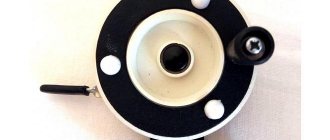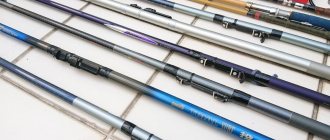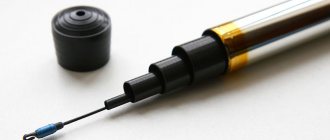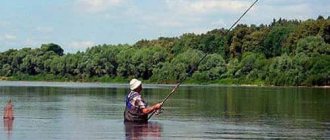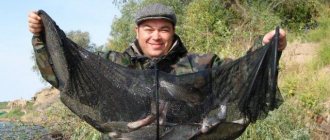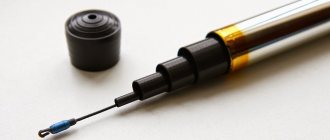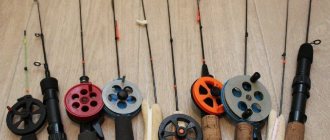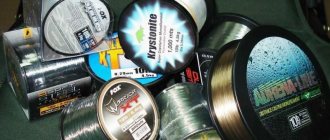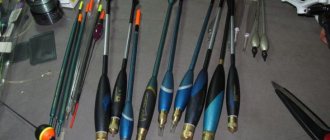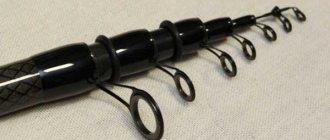| Place | Name | Characteristics in the rating |
| The best inexpensive float fishing rods: budget up to 2,000 rubles. |
| 1 | MIKADO FISH HUNTER FLOAT 500 | The best test range for baits (up to 30 gr.) |
| 2 | Salmo TAIFUN ULTIMA 500 TELEROD | High quality workmanship. Capable of handling heavy loads |
| 3 | Black Hole Powerful 500 | Simplicity and practicality in operation. High reliability indicators |
| 4 | SIWEIDA VICTOR 2401501 | Best price |
| 5 | Maximus Archer MSA21L | The lightest rod (135 g) High degree of versatility |
| The best float rods: budget from 2,000 rubles. |
| 1 | Maximus Sorcerer Bolo STEGT600 | The best set of rods. High degree of reliability |
| 2 | SHIMANO ALIVIO CX TE 5-600 | Low weight (327 g) with good load capacity |
| 3 | SHIMANO NEXAVE AX TE GT 7-450 XH | Wide range of bait test (30-100 gr.). Extra heavy class rod |
| 4 | Salmo DIAMOND POLE LIGHT MF 7.01 | Longest rod (700 cm) |
| 5 | Norstream Flagman Pole FLPM-500 | Lowest price for a fishing rod. The best ergonomic indicators (weight 235 g.) |
Fishing with a float has always been considered an unspoken symbol of fishing as an activity, but recently it has begun to fade into the background. This arrangement of roles led to the reorientation of production by many large companies to the production of more popular spinning and casting rods, leaving authentic float rods out of business.
Over time, the situation was normalized through a serious surge in the popularity of float fishing among domestic users. However, it was not possible to achieve a comparable surge in activity from manufacturing companies, and today the product range is represented mainly by little-known second-rate companies. Making a choice in such conditions turns out to be by no means easy - not for experienced fishermen, and even more so for those new to fishing. In this regard, we have selected for you a portion of the best float rods from well-known companies that meet the criteria of two price categories. The following parameters were chosen as criteria for selecting products for the rating:
- popularity of the manufacturer in the Russian Federation;
- reviews from consumers and experts;
- ergonomic indicators of products;
- manufacturing quality and structural reliability;
- price criterion;
- operational characteristics.
Types of float rods for long casting
The main “disadvantage” of gear with a line end fastening is the limited fishing radius. However, how you want to cast further away, to the treasured edge, to a bush sticking out of the water. And to achieve these goals, float fishing rods for long casting are used - match and Bolognese. Although the latter was originally conceived for other purposes. Therefore, it is possible to classify a lapdog as a tackle for long casts with tension.
Bolognese fishing rod
That telescopic fishing rod, equipped with guide rings and a spinning reel, which is used by amateur fishermen everywhere, can be called a Bolognese fishing rod. The main reason for the convention is the use of gear.
Yes, we are all accustomed to thinking that if there is a reel, there must be a long cast. There is logic. However, the main task for the Bolognese fishing rod is to catch fish while fishing in rivers. Where there is at least some current.
A Bolognese float rod can be used to make ultra-long fishing trips at a considerable distance from the shore. And since the rods have a power reserve and a significant supply of fishing line on the reel, they allow the angler to compete with large and strong prey. The first thing that comes to mind as an example is large bream.
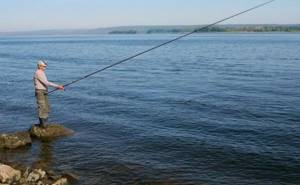
Due to the fact that popular fishing with a Bolognese fishing rod often takes place in stagnant bodies of water, one can judge its versatility. However, I assure you that to master the skill of controlling the tackle, you need to try hard. The effectiveness of fishing depends on the accuracy of bait delivery and complete control. But doing this with a long 5-8 meter rod, when the float is at a great distance from the fisherman, is not an easy task.
However, if you have the desire to master the tackle, it’s only a matter of time.
Match fishing rod
The match is, in every sense, a float tackle for long-distance casting.
Externally, the fishing rod is similar to a Bolognese fishing rod. It also consists of several parts (elbows), a reel seat. Budget fishing rods are usually of the telescopic type. “Advanced” - plug-in. The number of guides varies depending on the length of the rod, but there are significantly more of them than on the Bologna. They are smaller in shape and are on high legs.
The fishing line in the guides comes into less contact with the rod blank during rain and rain, which prevents it from sticking.
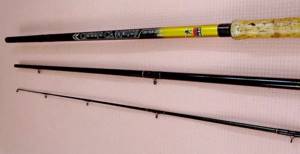
Since the match rod has English roots, the lengths of branded rods are displayed in feet. 14 - 15 feet are 4.2 and 4.5 meters, respectively.
Match fishing involves fishing with two types of equipment - with a sliding and a “deaf” (fixed) float. A “deaf” float is designed for fishing in places where the length of the rod exceeds the depth by at least half a meter. The sliding float is more versatile. With such equipment you can adapt to any depth.
Correct match floats are attached to the fishing line at one point. There is a special name for them - waggler.
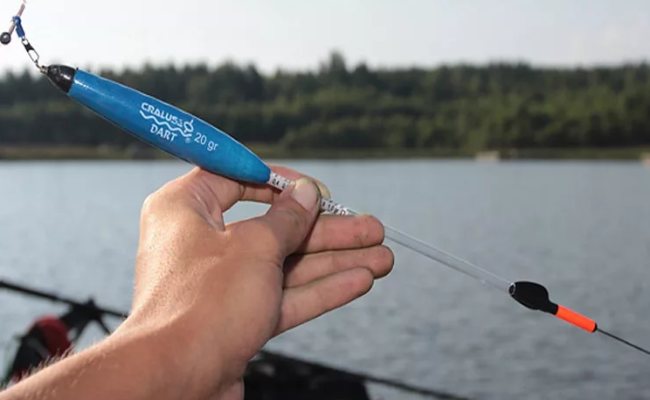
They have internal loading, which is undoubtedly a “plus” when using thin equipment.
Fly fishing rod
Fly fishing rods, as a rule, have a blind rig with a rod without guide rings. This is the most common tackle, the rod of which was previously made from walnut, maple, and bamboo whip. Later they began to use glued structures. Modern fly rods are made of carbon fiber or fiberglass and have several elbows for ease of transportation. The fly rod can be telescopic or plug-in (with connectors). The first option is easier, the second is more reliable. The equipment of such rods is assembled in advance and stored on the reel. For full fishing with a fly rod, you should have several reels with ready-made equipment with different loads and types of floats. This will allow you to quickly reconfigure the gear for changing fishing conditions or the type of fish, as well as quickly replace the equipment in case of breakage. The main line is attached to the tip of the rod through a rubber shock absorber using a connector - a special fastener. The shock absorber is a piece of aircraft model rubber of circular cross-section, 15-20 cm long, with a swivel for attaching to the connector. In addition to strength and reliability, an important characteristic of a fly rod is its lightness, since it is designed for long-term manipulation in the hands. Holding a heavy, unbalanced fishing rod is still a pleasure. In this case, preference should be given to a carbon fiber “telescope”. It should be borne in mind that the number of elbows and the wall thickness of the blank directly affect the weight of the fishing rod, action, as well as power, and the fewer there are, the lighter, more sensitive and maneuverable the fishing rod will be.
Selecting the length of the fly rod
Usually, when fishing with a fly rod, anglers take with them 2-3 rods of different lengths with a supply of reels for each. Taking into account the peculiarities of working with such equipment, the distance from the tip of the fishing rod to the hook should be 20-40 cm shorter than the length of the rod. The actual length of the rod itself is determined by the fishing conditions and the experience of the fisherman, but usually they range from 3.0 to 7.0 meters for telescopes. Longer ones are rarely used, as they become too heavy and not maneuverable. Fly rods with plug connections can be 9.0 meters or more in length, but are used mainly for sport fishing. For the convenience and comfort of fishing, it will be useful to correctly balance the rod blank to suit you. To do this, you can attach a weight to the butt under the plug, which will balance the end of the fishing rod and the butt relative to the usual position of the hand grip - such a rod will be easier to maneuver, and the hand will get less tired. The only disadvantages of a fly rod are the limitation of fishing depth and the distance to the fishing point from the shore. At the same time, the huge advantages are ease of use, light weight and reliability.
Fly rod test
The rod test is determined by the range of equipment weights in which this particular blank can be used effectively. The longer the fly rod, the heavier the equipment used and the larger the upper limit of the test. It is better to make a choice based on the average weight of all equipment. For example, if the weight of your equipment is approximately 15 grams, then the rod test indicated on the form should be about 10-20 or 8-25 grams. If you often have to fish with thin lines and light floats with a small load (bleak, roach, silver bream), then you should pay more attention to the lower limit of the test - it shows the minimum weight of the equipment with which this rod can be used. To make sense of the above, imagine that you need to throw a 1 gram sinker. on a 5-meter line with a thickness of 0.11 mm using a high jump pole. Do you think it will work out...? Therefore, you should pay attention to the correct selection of rod test.
Strength and structure of the fly rod
Cases often occur when, when fishing for roach or small crucian carp,

The bait is taken by a large bream or carp. The result in such a situation can be fatal for light tackle, unless you have a strong enough rod of the correct action in your hands. The strength of a fishing rod depends on who made the fishing rod and from what materials. Serious manufacturers accurately match the strength and flexibility of the blank material with the stiffness of the knees. In this case, the rigidity along the entire length of the fishing rod decreases evenly, without giving “jumps” at the joints, and as a result, the bending moment is distributed evenly throughout the fishing rod, without stress concentrators, in which destruction of the material usually occurs under peak loads.
Fly rod equipment
The equipment of a classic fly fishing rod consists of a float, the main line, several weights distributed along the line, a leash and a hook. As already described above, the fishing line is attached to the end of the rod using a connector, which allows you to quickly replace the float equipment. Connectors are selected according to the diameter of the tip and installed with waterproof glue. If there is a possibility of a large fish biting, it is worth installing a rubber shock absorber between the connector and the main line - it will reduce the risk of the tackle breaking during a sharp jerk and provide a reserve of power for swinging the rod when hooking.
Fly rod float
The main bite alarm when fishing with fly tackle is a lightweight float for blind rigs. The different shape of the float body, the length of the keel and antenna depend primarily on the speed of the current, wind, depth and other fishing conditions. Typically, the longer the rod, the greater the weight and carrying capacity of the float. An important component of the correct operation of the flywheel equipment is the accurate loading of the float. There are several loading methods for different fishing conditions. The main rule when loading a float: the float-sinker pair should not provide noticeable resistance to the fish when biting, and all the tackle should be as sensitive as possible. It is better to place the sinkers not pointwise, but distribute them along the line from top to bottom from heavier to lighter - this increases the sensitivity of the tackle and reduces the risk of entanglement when casting or empty hooking. You can read more about the different types of floats for fly fishing and how to use them here.
Main line and leash for fly fishing
The thinner the main line and leader, the less visible they are to the fish and the less they resist wind and water flow. Therefore, most often for fishing with fly tackle, monofilament transparent or colored fishing line with a cross-section of 0.16-0.20 mm and leashes no thicker than 0.12 mm are used. The low strength of such gear is fully compensated by the rubber shock absorber, the flexibility of the rod, the elasticity of the fishing line and competent, careful fishing for the caught prey. The diameter of the fishing line and leash can be larger only if you intend to catch very large fish or a predator, such as perch or pike with live bait.
Features of fishing with a fly rod
With this method of fishing, you can actively use bait, experiment with different attachments and baits, and easily change the depth and place of fishing. If we found fish, we stopped, fed them, and fished in that spot while there was a bite. Doesn't bite - move on

to another location in minutes. The fly rod allows you to easily fish in windows between water plants, in reed gaps, and place the bait precisely near a snag. An important point is hooking. Many novice fishermen make the grave mistake of hooking after a bite with a wave of their entire arm. In this case, the hook is delayed and the force is poorly controlled. Hooking should only be done with a brush! Fishing with a fly rod on a float will bring great pleasure to any fishing fan. This is one of the most ancient types of fishing, and nowadays it is also another reason to spend free time in nature. A fly rod is the simplest float tackle that even a child can operate.
Characteristics of a float rod
Rod build
In short (to understand the basic properties of the form resulting from the failure) there are two extreme systems:
1. FAST. These rods are characterized by a fast action blank. In rods of this type, the tip or whip and two upper legs work well for bending.
2. SLOW. These are slow action rods. In rods of this type it works, in the sense that the entire surface of the rod bends well.
Fast action rods allow you to make fast and strong hooks and quickly reel in prey. Most anglers consider the disadvantage to be the inability to effectively cast light baits of this type with a rod.
Slow action rods work well when playing fish for a long time, when you need to tire them out.
Power
The safety margin of a fishing rod is characterized by its power. This is a characteristic that allows you to select the ideal load for this form. The power of the rod allows you to determine the weight of the fish and the nature of the resistance of this fish. For the fisherman, careful care of this element of equipment will be an important factor.
Rod tip (tip)
This element of the rod design is characterized by the softness and elasticity of the tip (or whip). Most rod models on the market today have very stiff tips. At the same time, manufacturers produce fairly thin but powerful whips. If you are not able to buy an expensive branded rod, then it is enough to change the tip of a cheap rod. When fishing, the rod will work in a completely different way.
Butt diameter
This characteristic affects the windage of the rod. In strong winds, holding a rod with a thick butt becomes quite difficult. The best option if you often have to fish in difficult weather conditions is to choose a rod with a thinner butt.
Rod weight
This characteristic is taken into account by most anglers first. Most often you have to stand with a rod in your hands on the shore of a reservoir for quite a long time. Of course, a carbon fiber rod is easier to hold for 12 hours than a rod made of plastic and other composite materials. But you need to remember that losing weight does not always lead to an improvement in its other indicators, such as strength.
